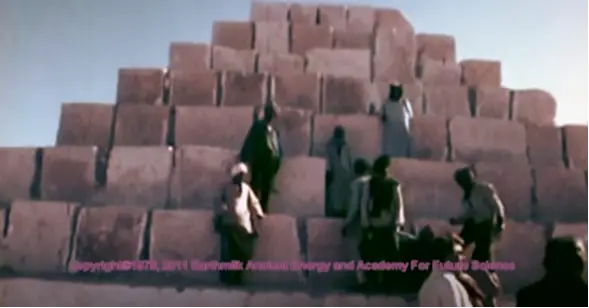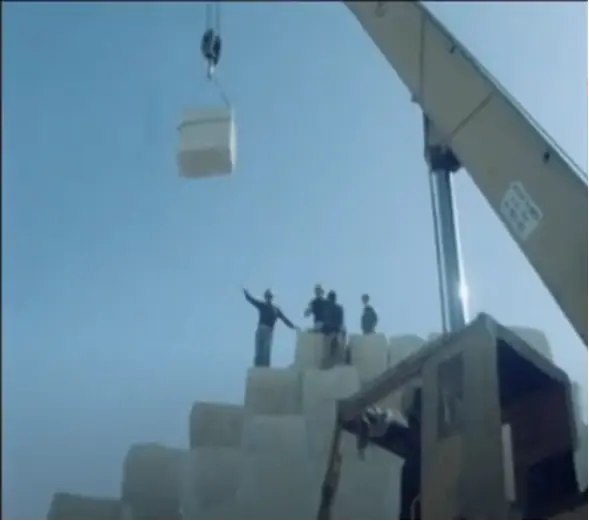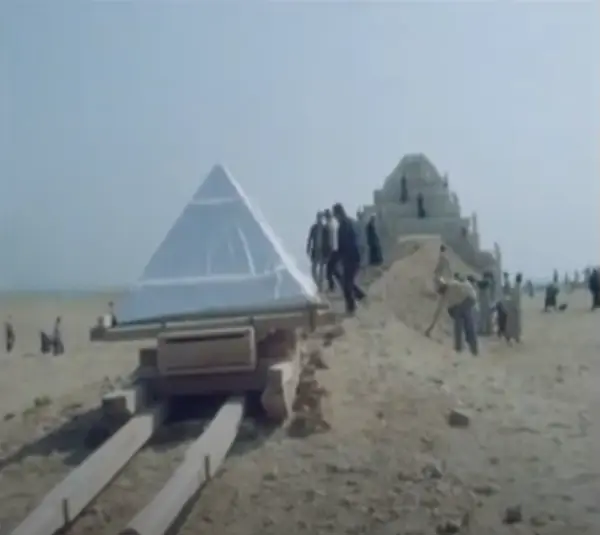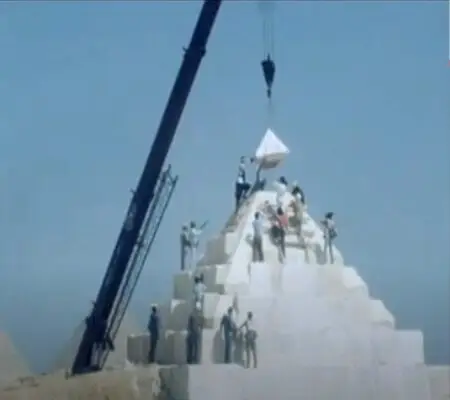The copy of the pyramid of Cheops revealed gaps in the version of the official history about construction technology.
How long scientists from the official history community have been struggling with the mysteries of the pyramid of Cheops, you can no longer remember. Apparently from the moment, she was found. Then they were joined by alternative researchers. Things haven't budged an inch. However, for some reason, both of them completely forgot about the experience of Japanese engineers who tried in 1978 to build a replica of the pyramid of Cheops, reduced by 15 times. Why? After all, it was a real construction with the use of technologies and tools from the time of Ancient Egypt.

People often write to me, saying, try to do something yourself with your own hands, then you will understand that people in ancient times were not at all armless, as you try to imagine them. That when building the pyramids, they used excellent construction skills and were hard enough to build the pyramid of Cheops in 20 years. And I do not dispute that the ancient Egyptians, we are talking about them in this case, build something. And of course, they built with the tools that they had at that time. Only they didn't build the pyramid of Cheops. That's the whole point.
And I also want to say to my opponents, who always force me to do something with my own hands - it is not necessary to be able to do it. It is quite enough that there are specialists who do it much better than me. And I have enough of their opinions. It remains only to analyze the information received. What I suggest you do with the example of building a copy of the pyramid of Cheops.

This significant event in modern history took place in 1978. Really. There are reports and videos about it. Even an article in the New York Times dated 08.03.1978.
Stone by overpriced stone, a Japanese television company set out on the western edge of Cairo to raise a pyramid on a desert rise overlooking the Great Pyramids of Giza, with the assistance of a Japanese master craftsman, two cranes, a fork lift vehicle and hundreds of bags of Rumanian cement.
The imitation will not endure the sands of time because the Egyptian Government wants the pyramid dismantled and hauled away. The work, when visited the other day, was only six days behind schedule. Egyptian laborers in dusty robes and turbans staggered under baskets filled with sand to shore up a ramp. A Japanese in a white plastic helmet waved into position one more three‐ton block of limestone dangling from heavy crane.
An article in the New York Times. https://nyti.ms/3giGlsu:
However, after disassembling the copy of the pyramid by agreement with the Egyptian authorities this event was classified as a hoax. Why? Yes, because the Japanese engineers could not repeat the heroic experience of the ancient Egyptian-builders, who with incredible efforts under the rays of the scorching sun built a real pyramid.
Analyzing the information I received, I identified four gaps in the version of the official history that tells us how the pyramids were built. Only four, although there are many more. But even these four completely negate the official version. Completely!
So. As far as we remember, the pyramids were built like this:
1) the blocks were cut in a quarry using wooden wedges;
2) sawed and leveled the blocks with copper saws, using ropes as a meter;
3) dragged blocks from the quarry with the help of sleds or round rollers;
4) the blocks were brought up using a specially built ramp.
All this was fully adhered to by the Japanese engineers of the company Nippon Corporation. You can watch a video about the construction of a copy of the pyramid of Cheops at the link below.

The blocks are uneven.
It was decided to make a copy of the pyramid of Cheops with a base size 15 times smaller than the original, with a height of only 10 m, and the size of the blocks was no more than 3 tons. Japanese engineers expected to build a replica in just 1 month, using the construction methods and technologies of antiquity. However, from the very beginning of construction, everything went wrong.
The use of wooden wedges for cutting down blocks in the quarry led to a huge amount of marriage. When the blocks were excavated from the common monolith, the splits occurred not only along the lines outlined by the wedges but also along the cracks inside the blocks. That is, instead of rectangles, blocks of completely different sizes were obtained. Moreover, the use of copper saws did not help at all. It turned out that the saws for cutting granite were ineffective.

Use a crane.
Realizing that such punctures increase the construction time several times, the engineers decided to use jackhammers in the quarry. Like this. And this is just the beginning. Then it turned out that the use of ropes as a meter led to the fact that the blocks began to differ not only in shape but also in size. And this in turn led to the instability of the blocks in the pyramid itself. That is, between the blocks, you could put not only a razor blade but also a hammer with a chisel.
The most fun was the technology of transporting three-ton blocks to the construction site.
With the help of rollers, it was impossible to deliver them, because, on the sand, the rollers became unmanageable, the blocks constantly rolled off them, and the rollers themselves parted. The stones had to be dragged onto the ice rinks again and again. Moreover, moving the blocks in the heat was a very unpleasant task for the workers. So after some time, realizing that this way the blocks could not be delivered, it was decided to use modern technology again. In this case, trucks.
And finally, the famous ramp, which turned out to be just huge. In addition, maintaining it in working order also required time and effort. I'm not even talking about the fact that the blocks were supposed to be raised on it with grease, that is, the ramp was watered with oil. However, it was not only the blocks that slid along it but also the builders themselves. Then it was decided to use cranes, which, according to historians, Egyptian builders raised stones. Cranes were built from palm trunks and ropes. But such equipment could not withstand a load of even 1 ton and fell apart.

Pyramidion
Having failed, the Japanese completed the construction of the pyramid by climbing to the top of the pyramid with a modern crane. As a result, the construction of a copy of the pyramid of Cheops took not 1 month, but a whole year! So much for the great ancient builders. But Japanese engineers proved that it is IMPOSSIBLE to build as the official history tells us.

Completion of construction.
It would be good to think about it more often. However, after disassembling the copy, it was safely forgotten. Although a few videos have survived, although there is a very little showing of the construction itself. But the copy of the pyramid of Cheops and its features are clearly visible. It seems that the earlier movie has already been "lost". Therefore, we will continue to try to impose versions that can be built using primitive methods, and that there was no ancient civilization before us.
About author:
Serg Toporkov Ufologist, Ph.D., blogger, I go on my own expeditions for UFOs. I use scientific methods to investigate the UAP phenomenon. Write to me |
Related tags:
the pyramid of Cheops history reconstruction conspiracy pyramidRandom UFO or conspiracy article
The former director of the CIA spoke about flying saucers
 Former CIA Director John Brennan said it would be "presumptuous and arrogant" to think that people are alone in the universe. The ex-head of the intelligence agency commented on the declassified UFO videos in the United States.
Former CIA Director John Brennan said it would be "presumptuous and arrogant" to think that people are alone in the universe. The ex-head of the intelligence agency commented on the declassified UFO videos in the United States.
